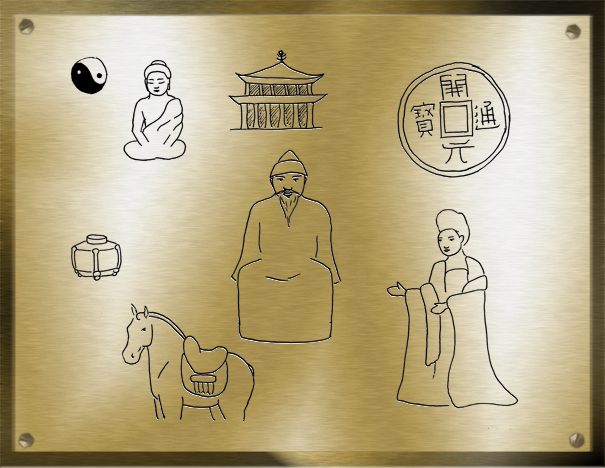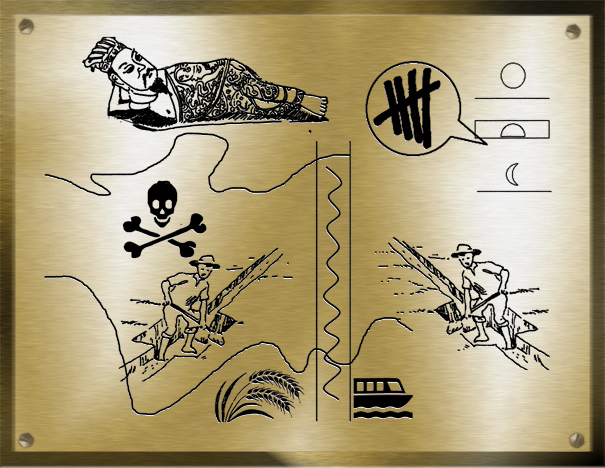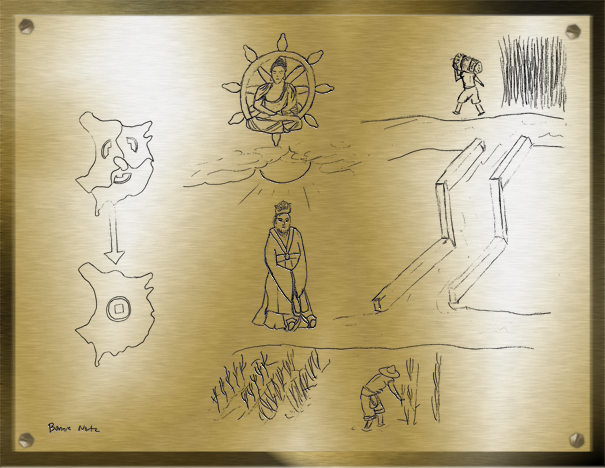| Time Period | High Tang Period (during the Tang Dynasty) (c. 8th century CE) |
| Geographical Region | Eastern half of modern-day China, south of Manchuria |
| List of Symbols |
|
My plaque is representative of the High Tang period, often called the Golden Age of Chinese history. During this period, immense wealth and great contributions to culture were built. The Tang period was a very important period in Chinese history, as the changes brought about during it impacted Chinese history for hundreds of years to come.
The man on the plaque signifies the position of emperor during the dynasty. Like in previous dynasties, the emperor was the head of state in the empire. The emperor was an incredibly strong presence in the government during the high Tang period, and the emperors during the high Tang period were able to implement important and vast changes in governance, including a new legal code, a new economic system, and more patronization of religion and the arts. If the emperor were depicted in color, he would be wearing yellow, since that was the imperial color and signified his power as Son of Heaven and controller of the land around the Yellow River.
The woman is representative of women’s place in Tang society. Though the society was very much patriarchal, women played a very important role for several pivotal events. The woman depicted in my design is an example of the Tang ideal of feminine beauty, with a round face, high hair, and flowing garments. Women played an important role for politically affluent families, as they allowed influential families to form alliances and gain advantages through marriage into other important families. Powerful women also played an influential role at court, wielding influence through control of their husbands or sons, or even ruling as a dowager empress. (Later, a woman would even take the empire’s throne and rule as emperor in her own right.)
The coin is representative of the economy of the period. Though bronze coins, like the one depicted, were very important in the economy, they were not the only type of currency. Silk and silver were equally as important in the economy, with silk being almost more valuable. The Tang dynasty also implemented land redistribution in a program called the equal-field system. Families were given specific allotments of land, based on the number of people in the household as well as their situation in life. They were then required to pay taxes and perform government-mandated labor in exchange for the land. For all the economic success of the Tang dynasty, the equal-field system never managed to bring the government a good source of revenue.
The Buddha statue and the pagoda/monastery represent the importance of Buddhism during the Tang period. The government strongly supported Buddhism during this time, and though the empire remained strongly Confucian, Buddhism also played a very important role in society. Influential families sponsored monasteries and monks, encouraging the building of religious sites and the translation and writing of religious documents.
The yin yang symbol represents Daoism. In addition to the state support of Buddhism, Daoism continued to be an important religious presence for citizens of the empire. Daoism along with Buddhism allowed the people to find serenity in life, in addition to reassurance about their personal and their family members’ place in the after-life.
The pottery and horse are representative of the rich culture and artwork of the time. The period is very famous for its development of many styles, including pottery, porcelain, paintings, calligraphy, and more. Since the period was marked by prosperity, people were able to afford patronizing the arts. Ceramic art was especially well developed during this time, and beautiful works of poetry and literature were also written.
These symbols are important because they represent some of the main important qualities and developments of the High Tang period. By understanding them, one is better able to understand the history and culture of the time, and therefore is better able to understand later developments in Chinese history.
 ELIZABETH SCHEUERMAN is a History, English, and Art History major at the University of Rochester. She works at UR’s Department of Rare Books & Special Collections, and hopes to pursue a career in Museum Studies. In her free time, Elizabeth enjoys foreign films and reading. More by Elizabeth
ELIZABETH SCHEUERMAN is a History, English, and Art History major at the University of Rochester. She works at UR’s Department of Rare Books & Special Collections, and hopes to pursue a career in Museum Studies. In her free time, Elizabeth enjoys foreign films and reading. More by Elizabeth




 BONNIE NORTZ is a double major in Mathematics and Linguistics, with a minor in Computer Science. This year she is a Take Five student for Chinese Language and Art. She is also involved in SOCKS and Swing Dance Club.
BONNIE NORTZ is a double major in Mathematics and Linguistics, with a minor in Computer Science. This year she is a Take Five student for Chinese Language and Art. She is also involved in SOCKS and Swing Dance Club.